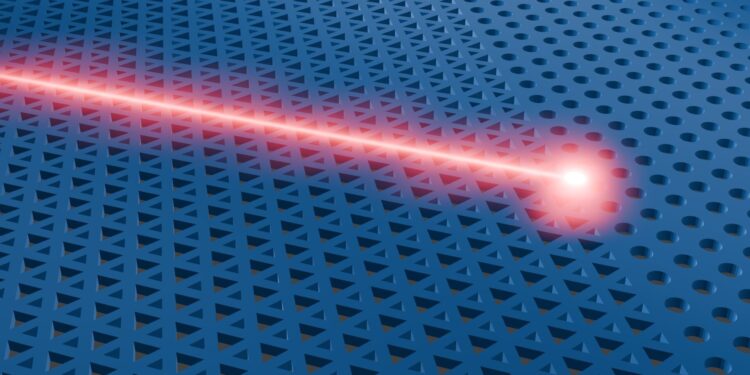Impression of the artist from light concentration to the “wall” at the end of the wave guide. Credit: Amolf
Concentrating light in a volume as small as the wavelength itself is a challenge that is crucial for many applications. Researchers from Amolf, Tu Delft and Cornell University in the United States have demonstrated a new way of focusing on an extremely small scale. Their method uses special properties of a photonic crystal and works for a wider spectrum of wavelengths than alternative methods. Researchers have published their results in Scientific advances April 18.
The concentration of light is important for various technological applications on photonic chips, such as quantum communication, optical sensors and lasers on chip. “Until now, we have known two general strategies to concentrate light: this can be done using optical cavities, or with wave guides that compress light as a funnel,” explains Ewold Verhage, leader of the Amolf group.
“The first method uses resonance, which limits the focus or concentration of light to a specific wavelength. The second method works, similar to a traditional lens, only in a much larger device than the wavelength of the light used.”
Bloc
A theoretical idea of researchers from Cornell University, led by Gennady Shvets, underlined the new method that doctorate. The candidate Daniel Muis and his colleagues have now demonstrated for the first time. An important aspect of the method is the so-called topology of the physical system.
Muis explains: “We use photonic crystals, which are silicon slabs with a regular motif of very small holes, which prohibiting the propagation of light in the silicon slab, in principle. But, when we place two of these crystals with a mirror motif side by side. The reflection of light by imperfections in the crystal is deleted.”
The researchers wondered what would happen if they suddenly finished such a wave guide, with a “wall” of material that light cannot cross. “Since the light has nowhere to go and that the reflections are deleted, it should accumulate in front of this wall,” explains Muis. “Light ultimately bounces through the wave guide, but only after a delay. This results in a local amplification of the light field.”
Left: an image of electronic crystal electron microscopy of silicon. The topological wave guide is formed on the border between the green and blue regions, and is finished by the crystal with round holes on the right side. Right: a measurement of optical intensity in the photonic crystal. Light penetrates through the topological wave guide of the left and accumulates at the end of the wave guide due to the deleted back reflection. Credit: Amolf
Light concentration
The Groups of Vergen in Amolf and Kobus Kuipers from Tu Delft have decided to check the predictions in an experience with the researchers of Cornell. The topological wave guides were made on a Amolf silicon chip. To visualize the planned accumulation of light in the photonic crystal, Muis used a unique microscope to Ti Delft which scans the light fields via an ultra-thin needle above the surface of the crystal. This microscope can locate the intensity of light on a scale about 1,000 times smaller than the thickness of human hair.
“We have indeed seen a clear amplification of the light field at the end of the topological wave guide. Interestingly, this only happened when the” wall “ending the wave guide was placed at a certain angle. This is exactly what our Cornell partners had predicted,” explains Muis.
“This proves that the light amplification is linked to the topological removal of the thinking of the back. The light amplification is concentrated in a very small volume, as small as the wavelength of the light itself. A major advantage of this method is that it is intrinsically wide to band: it works for several different wavelengths.”
The article in Scientific advancesWith equal contributions from Muis and his colleague Cornell Yandong Li, can be read as a recipe for additional research or applications of this light amplification form on a chip. The demonstrated mechanism must also apply to any other type of wave in a structured medium, including sound waves or even electrons in specific crystals.
Muis says: “For a next step, it would be interesting to use a pulsed laser to look at the time interval in which the light continues to accumulate, to see to what extent the amplification of the field can be maximized and use it for applications in the manipulation of light on optical fleas.”
More information:
Daniel Muis et al, a large strip location at the end of a topological photonic wave guide, Scientific advances (2025). DOI: 10.1126 / SCIADV.ADR9569. www.science.org/doi/10.1126/sciadv.adr9569
Quote: The new mechanism uses a photonic crystal to focus light on a chip (2025, April 18) recovered on April 19, 2025 from
This document is subject to copyright. In addition to any fair program for private or research purposes, no part can be reproduced without written authorization. The content is provided only for information purposes.



